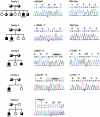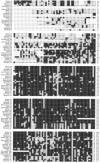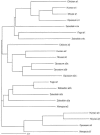Hereditary hypophosphatemic rickets with hypercalciuria is caused by mutations in the sodium-phosphate cotransporter gene SLC34A3
- PMID: 16358215
- PMCID: PMC1380229
- DOI: 10.1086/499410
Hereditary hypophosphatemic rickets with hypercalciuria is caused by mutations in the sodium-phosphate cotransporter gene SLC34A3
Abstract
Hypophosphatemia due to isolated renal phosphate wasting results from a heterogeneous group of disorders. Hereditary hypophosphatemic rickets with hypercalciuria (HHRH) is an autosomal recessive form that is characterized by reduced renal phosphate reabsorption, hypophosphatemia, and rickets. It can be distinguished from other forms of hypophosphatemia by increased serum levels of 1,25-dihydroxyvitamin D resulting in hypercalciuria. Using SNP array genotyping, we mapped the disease locus in two consanguineous families to the end of the long arm of chromosome 9. The candidate region contained a sodium-phosphate cotransporter gene, SLC34A3, which has been shown to be expressed in proximal tubulus cells. Sequencing of this gene revealed disease-associated mutations in five families, including two frameshift and one splice-site mutation. Loss of function of the SLC34A3 protein presumably results in a primary renal tubular defect and is compatible with the HHRH phenotype. We also show that the phosphaturic factor FGF23 (fibroblast growth factor 23), which is increased in X-linked hypophosphatemic rickets and carries activating mutations in autosomal dominant hypophosphatemic rickets, is at normal or low-normal serum levels in the patients with HHRH, further supporting a primary renal defect. Identification of the gene mutated in a further form of hypophosphatemia adds to the understanding of phosphate homeostasis and may help to elucidate the interaction of the proteins involved in this pathway.
Figures







References
Web Resources
-
- Ensembl, http://www.ensembl.org/ (for proteins from chicken [accession numbers ENSGALP00000004850 and BU122185], Xenopus [accession numbers ENSXETP00000050672 and CX972852], zebrafish [accession numbers ENSDARP017391, C0920054, ENSDARP00000041987, and CR929642], and Fugu [accession numbers SINFRUP00000132898 and SINFRUP00000149494])
-
- ExonPrimer, http://ihg.gsf.de/ihg/ExonPrimer.html
-
- GenBank, http://www.ncbi.nlm.nih.gov/Genbank/ (for sequences from human [accession numbers NP_003043.2, NP_006415.1, and NP_543153.1], mouse [accession numbers NP_035522.1, NP_035532.1, and NP_543130.1], chicken [accession number NP_989805], Xenopus [accession number AAH67316.1], and zebrafish [accession numbers NP_571699.1 and AAG35356.2])
-
- MAP-O-MAT, http://compgen.rutgers.edu/mapomat/
-
- Online Mendelian Inheritance in Man (OMIM), http://www.ncbi.nlm.nih.gov/Omim/ (for HHRH, ADHR, and XLH)
References
-
- Chen C, Carpenter T, Steg N, Baron R, Anast C (1989) Hypercalciuric hypophosphatemic rickets, mineral balance, bone histomorphometry, and therapeutic implications of hypercalciuria. Pediatrics 84:276–280 - PubMed
Publication types
MeSH terms
Substances
LinkOut - more resources
Full Text Sources
Molecular Biology Databases

